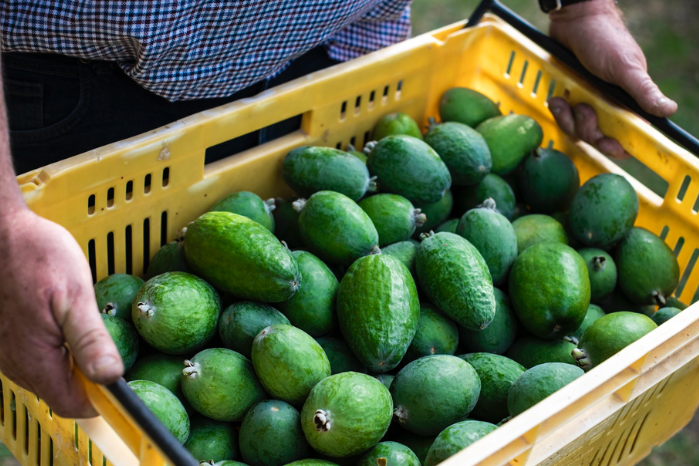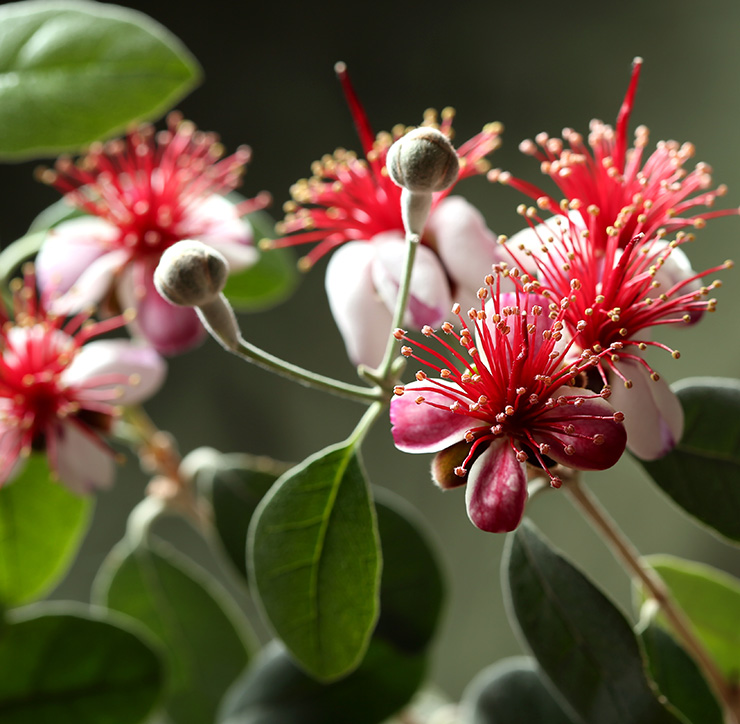Fast delivery - NZ wide
Shop our Mother's Day gift box range
Free shipping on all orders $98 and over
Orders close Tuesday 2pm each week
Free gift with first your purchase
Fast delivery - NZ wide
Shop our Mother's Day gift box range
Free shipping on all orders $98 and over
Orders close Tuesday 2pm each week
Free gift with first your purchase
Possibly even more kiwi than the Kiwifruit, feijoas are a key part of our fruity heritage. Let’s look into how NZ began its love affair with the feijoa...
Let’s face it, feijoas scream Kiwi-ness.
After all, what is a New Zealand autumn without digging the zingy flesh of a feijoa out of its skin? Sometimes there is not even time to grab a spoon when the backyard craving calls! But that’s only for the hardcore feijoa lovers.
Possibly even more kiwi than the Kiwifruit, the fragrant feijoa is a key part of our fruity heritage. Luckily for us, these gorgeous green orbs are usually available in abundance at this time of year. Meaning, we can scoff them by the bucketload!
So, why are we so obsessed with this odd little fruit?
Let’s look into how New Zealand began its love affair with the feijoa...

New Zealand’s subtropical climate is ideal for this hardy variety. The shrubs themselves (which resemble miniature pohutukawa trees) make excellent windbreaks and hedges. Just head out into almost any neighbourhood in the country and you will be able to scoop them off the ground in many front and backyards. Just make sure to ask permission before helping yourself to your neighbour’s stash!
Easy to eat and a delight to bake with, the feijoa deserves its time in the spotlight. So let’s tear one open and have a look at the history and nutritional value of one of our favourite fruits.
As much as we would like to claim the feijoa as our own, the Acca sellowiana actually hails from South America. It is found naturally in southern Brazil, Uruguay, Paraguay and Argentina. It was discovered by German explorer Freidrich Sellow in 1815 and ended up in Europe.
It wasn't until the 1920s that the fruit - also known as pineapple guava or guavasteen - arrived on our shores.
It is funny to think that only our recent ancestors got to sample something so synonymous with today’s kiwi culture.
Health-wise, feijoas pack a real punch. They are delightfully low in calories. 100 grams of the flesh only contains 55 calories, so feel free to gorge on them without too much guilt. But be warned, they are also high in dietary fibre, so if you scoff too many, you may find your bowels are working a little too well!
There is a generous serving of Vitamin C. Just 100g provides just half your recommended daily intake - perfect for boosting your immune system in the lead up to winter. You will also get small amounts of B vitamins, calcium, magnesium, manganese and iron, too.
Ripe feijoas should be slightly soft to press, without being squishy. Once ready to eat, they will get overripe quickly, so should be stored in the fridge until you are ready to enjoy them. For a bumper crop, it is no problem to keep some of them in the freezer.

Now for the fun part! Of course, you can rip the fruit open with your bare hands and scoop the jelly centre out with a spoon - or just tear into it with your teeth. But there are so many other ways to utilise feijoas.
Add it to a juice or smoothie for a distinctive sweet flavour, use the pulp in place of bananas in a banana cake recipe, chop them up into a salad, stew them, or make mouthwatering jams or chutneys.
The aromatic nature of feijoas also translates beautifully to alcoholic beverages. So they are perfect to add to your favourite cocktails. Or, if you are into a bit of home-brewing, you can craft feijoa cider, feijoa wine, or even feijoa infused vodka!
Pro tip: snack on the petals of the shrub’s flowers - they taste like sherbert! Don’t go crazy though, or you’ll deprive yourself of fruit later in the season.
Love feijoas as much as we do? Then head on over to the store to order yours now!
